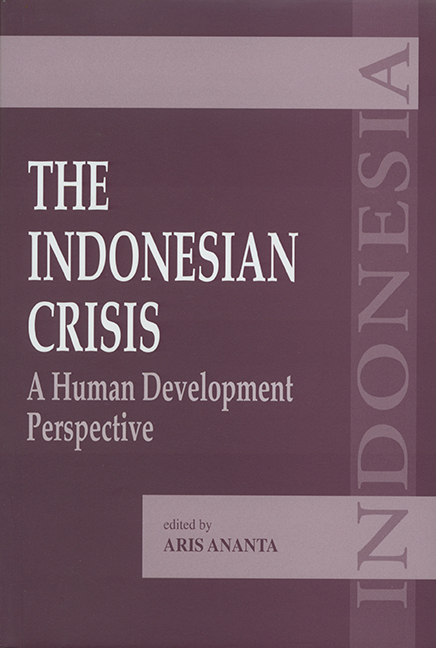Book contents
- Frontmatter
- Contents
- Acknowledgements
- List of Contributors
- Part I Introduction
- 1 What Do We Learn from the Crisis? Insights on Human Development in Indonesia during 1997–99
- 2 Macroeconomic Recovery: Facts and Prospects
- 3 Indonesia's Economic Transformation: Before and During the Economic Crisis
- 4 Modelling the Repercussions of Financial Shock on Socio-economic Indicators
- Part II Human Capital
- Part III Purchasing Power
- Part IV Emerging Issues
- Index
4 - Modelling the Repercussions of Financial Shock on Socio-economic Indicators
from Part I - Introduction
Published online by Cambridge University Press: 21 October 2015
- Frontmatter
- Contents
- Acknowledgements
- List of Contributors
- Part I Introduction
- 1 What Do We Learn from the Crisis? Insights on Human Development in Indonesia during 1997–99
- 2 Macroeconomic Recovery: Facts and Prospects
- 3 Indonesia's Economic Transformation: Before and During the Economic Crisis
- 4 Modelling the Repercussions of Financial Shock on Socio-economic Indicators
- Part II Human Capital
- Part III Purchasing Power
- Part IV Emerging Issues
- Index
Summary
Introduction
Despite the obvious deterioration of some socio-economic variables after the crisis, it is still not clear how the financial shock has transmitted into the social conditions. Almost all analyses on the subject have used socio-economic indicators “before and after”, and concluded that any deterioration detected was due to the financial crisis. Such an approach clouds the understanding of the real impact of the financial crisis. More seriously, it is methodologically inaccurate. While attempts to improve social conditions are always necessary, regardless of whether or not there is a crisis, it is equally important to disentangle the real causes of the damages. This is particularly so when policies to counter the crisis-driven damages are to be designed under limited resources, which is the usual condition in a crisis situation.
Moving from a “before and after” approach to a “with and without” one, however, would call for the use of some sort of model. The model should be capable of mapping out the mechanism through which various shocks in the financial variables are translated to selected socio-economic indicators, by taking into account the direct, indirect, and feedback effects.
The primary goal of this chapter is to show how such a model can capture the important events (shocks) during the crisis, and disentangle the impacts of different shocks on some socio-economic indicators. Obviously, the model contains a fairly detailed specification of the financial sector.
First, an economy-wide model of the structural path analysis type will be used to measure the total effects of the falling production in selected sectors as a result of the crisis. In the subsequent section, a more comprehensive model featuring endogenous prices is constructed and used to evaluate the sequence of the crisis period in Indonesia. The ultimate purpose of the study is to analyse the impacts of the crisis on selected socio-economic variables.
General Equilibrium Impacts of Production Shocks
The contraction of economic production caused by the crisis could result in severe retrenchment of demand for labour, causing unemployment to increase. In turn, the collapsed demand for a certain type of labour would affect the income and welfare of various household groups differently. Through feedback effects, the resulting income distribution would eventually affect the production structure. Hence, a circular causation between production, factor income, and household income is created.
- Type
- Chapter
- Information
- The Indonesian CrisisA Human Development Perspective, pp. 76 - 102Publisher: ISEAS–Yusof Ishak InstitutePrint publication year: 2002



